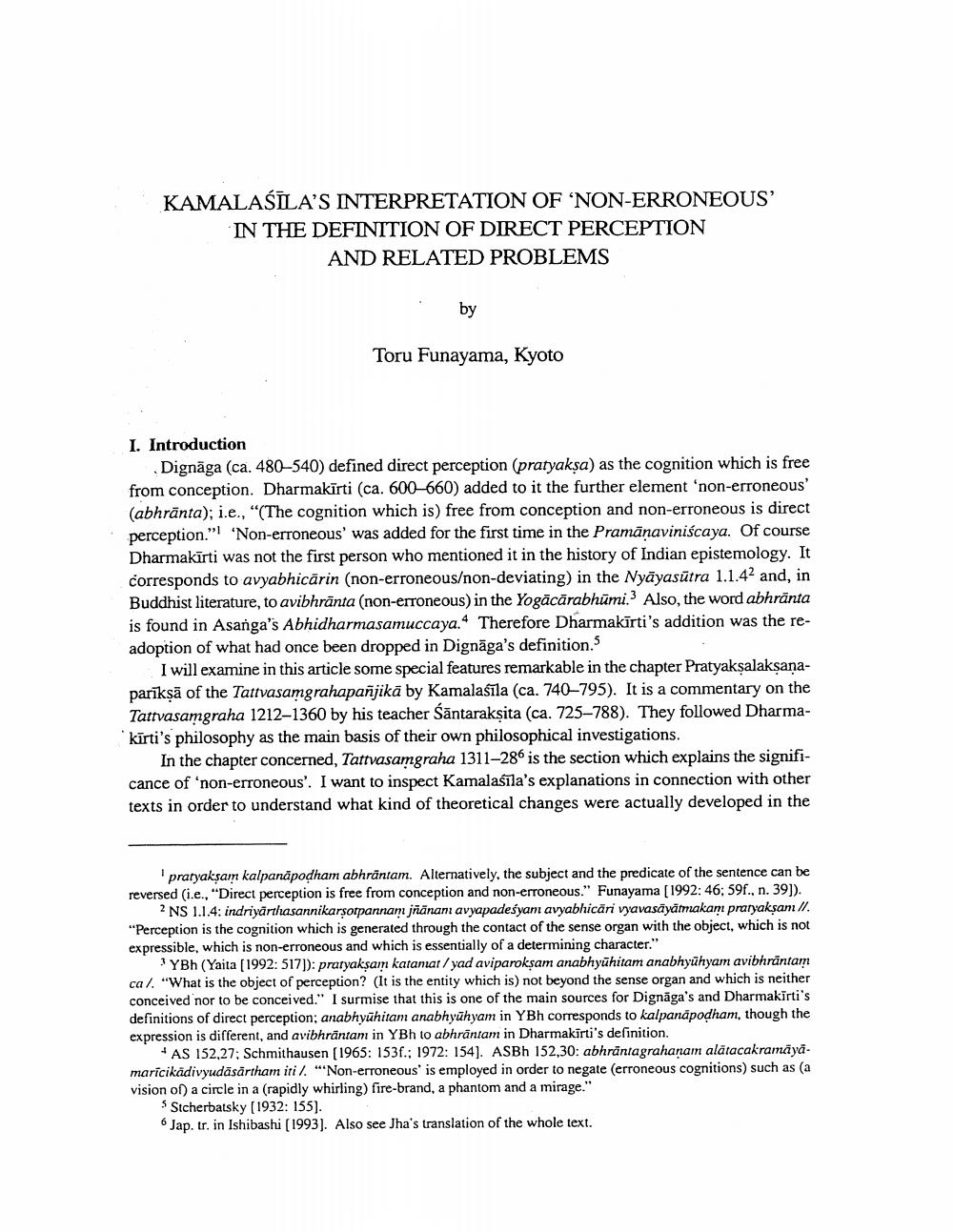________________
KAMALASĪLA'S INTERPRETATION OF ‘NON-ERRONEOUS' IN THE DEFINITION OF DIRECT PERCEPTION
AND RELATED PROBLEMS
.
by
Toru Funayama, Kyoto
I. Introduction
Dignāga (ca. 480-540) defined direct perception (pratyakşa) as the cognition which is free from conception. Dharmakirti (ca. 600-660) added to it the further element 'non-erroneous (abhrānta); i.e., "(The cognition which is free from conception and non-erroneous is direct perception."! 'Non-erroneous' was added for the first time in the Pramānaviniscaya. Of course Dharmakārti was not the first person who mentioned it in the history of Indian epistemology. It corresponds to avyabhicärin (non-erroneous/non-deviating) in the Nyāyasūtra 1.1.42 and, in Buddhist literature, to avibhrānta (non-erroneous) in the Yogācārabhumi? Also, the word abhränta is found in Asanga's Abhidharmasamuccaya. Therefore Dharmakīrti's addition was the readoption of what had once been dropped in Dignāga's definition.
I will examine in this article some special features remarkable in the chapter Pratyaksalaksanaparīkņā of the Tattvasamgrahapanjikā by Kamalasīla (ca. 740–795). It is a commentary on the Tattvasamgraha 1212–1360 by his teacher śāntarakṣita (ca. 725-788). They followed Dharmakīrti's philosophy as the main basis of their own philosophical investigations.
In the chapter concerned, Tattvasamgraha 1311–286 is the section which explains the significance of 'non-erroneous'. I want to inspect Kamalaśīla's explanations in connection with other texts in order to understand what kind of theoretical changes were actually developed in the
pratyakşam kalpanapodham abhräntam. Alternatively, the subject and the predicate of the sentence can be reversed (i.e., "Direct perception is free from conception and non-erroneous." Funayama (1992:46:59f., n. 39]).
2 NS 1.1.4: indriyarthasannikarşorpannam jñānan avyapadesyam avyabhicāri vyavasāyātmakam pratyakşam II. "Perception is the cognition which is generated through the contact of the sense organ with the object, which is not expressible, which is non-erroneous and which is essentially of a determining character."
YBh (Yaita (1992: 517]): praryaksam katamat/yad aviparoksam anabhyuhitam anabhyuhyam avibhrantam ca/. "What is the object of perception? (It is the entity which is not beyond the sense organ and which is neither conceived nor to be conceived." I surmise that this is one of the main sources for Dignāga's and Dharmakīrti's definitions of direct perception; anabhyūhitam anabhyuhyam in YBh corresponds to kalpanāpodham, though the expression is different, and avibhrāntam in YBh to abhrāntam in Dharmakirti's definition.
- AS 152,27; Schmithausen (1965: 153f.; 1972: 154). ASBh 152,30: abhrāntagrahanam alātacakramāyāmaricikādivyudāsärtham iti /. "Non-erroneous' is employed in order to negate (erroneous cognitions) such as (a vision of a circle in a (rapidly whirling) fire-brand, a phantom and a mirage."
5 Stcherbatsky (1932: 155). Jap. tr. in Ishibashi (1993). Also see Jha's translation of the whole text.




